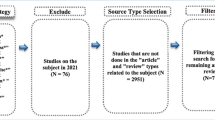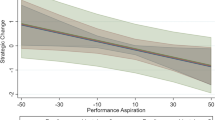Abstract
Family businesses provide a fertile ground to study emotions as a source of contradiction. The embeddedness of a business in an owner family influences strategic decisions in a way that differs from decision-making in nonfamily firms, such as ownership transition choices. I apply an emotional embeddedness perspective to explain ownership transition choices, which contradict the prevailing means–ends logic in management research. The interplay of relational and emotional embeddedness can lead to ownership transition choices that contradict an instrumental logic of action. Repeated interactions between actors with different roles in a family business shape the quality of the family’s structure and its effect on important strategic outcomes. Although family structure might be conducive to internal ownership transition, this choice is not always the preferred option because of intervening conditions and the application of alternative action principles. Researchers in the field of Contradiction Studies should probe into situations in the management context, in which circumstances may favor the application of a means–ends logic but fail to do so, in order to enhance our understanding of contingencies that foster alternative action principles in economic action and interaction.
Access this chapter
Tax calculation will be finalised at checkout
Purchases are for personal use only
Similar content being viewed by others
References
Aronoff, Craig E. 1998. Megatrends in family business. Family Business Review 11: 181–185.
Bandelj, Nina. 2009. Emotions in economic action and interaction. Theory and Society 38: 347–366.
Barbera, Francesco, Fabian Bernhard, Joshua Nacht, and Greg McCann. 2015. The relevance of a whole-person learning approach to family business education: Concepts, evidence, and implications. Academy of Management Learning and Education 14 (3): 322–346.
Beckhard, Richard, and W. Gibb Dyer. 1983. Managing continuity in the family-owned business. Organizational Dynamics 12: 5–12.
Berent-Braun, Marta M., and Lorraine M. Uhlaner. 2012. Family governance practices and teambuilding: Paradox for the enterprising family. Small Business Economics 38: 103–119.
Berrone, Pascual, Cristina Cruz, and Luis R. Gomez-Mejia. 2012. Socioemotional wealth in family firms: Theoretical dimensions, assessment approaches, and agenda for future research. Family Business Review 25: 258–279.
Bertrand, Marianne, and Antoinette Schoar. 2006. The role of family in family firms. Journal of Economic Perspectives 20: 73–96.
Biniari, Marina G. 2012. The emotional embeddedness of corporate entrepreneurship: The case of envy. Entrepreneurship Theory and Practice 36: 141–170.
Block, Jörn H. 2012. R&D investments in family and founder firms: An agency perspective. Journal of Business Venturing 27: 248–265.
Carney, Michael. 2005. Corporate governance and competitive advantage in family-controlled firms. Entrepreneurship Theory and Practice 29: 249–265.
Chalus-Sauvannet, Marie-Christine, Bérangère Deschamps, and Luis Cisneros. 2016. Unexpected succession: When children return to take over the family business. Journal of Small Business Management 54: 714–731.
Colli, Andrea. 2013. Family firms between risks and opportunities: A literature review. Socio-Economic Review 11: 577–599.
Davis, Peter S., and Paula D. Harveston. 1999. In the founder’s shadow: Conflict in the family firm. Family Business Review 12: 311–323.
De Massis, Alfredo, Federico Frattini, Emanuele Pizzurno, and Lucio Cassia. 2015. Product innovation in family versus nonfamily firms: An exploratory analysis. Journal of Small Business Management 53: 1–36.
de Pontet, Brun, Carsten Wrosch Stéphanie, and Marylene Gagne. 2007. An exploration of the generational differences in levels of control held among family businesses approaching succession. Family Business Review 20: 337–354.
Decker, Carolin, and Christina Günther. 2017. Family ownership and innovation: Evidence from the german machine tool industry. Small Business Economics 48 (1): 199–212.
Dunn, Barbara. 1999. The family factor: The impact of family relationship dynamics on business-owning families during transitions. Family Business Review 12: 41–60.
Family Firm Institute. 2017. “Global data points.” http://www.ffi.org/page/globaldatapoints. Accessed 26 Aug 2017.
Goel, Sanjay, Pietro Mazzola, Phillip Phan, Torsten M. Pieper, and Ramona K. Zachary. 2012. Strategy, ownership, governance, and socio-psychological perspectives on family businesses from around the world. Journal of Family Business Strategy 3: 54–65.
Gomez-Mejía, Luis R., Katalin T. Haynes, Manuel Núñez-Nickel, Kathryn J. Jacobson, and José Moyano-Fuentes. 2007. Socioemotional wealth and business risks in family-controlled firms: Evidence from Spanish olive oil mills. Administrative Science Quarterly 52: 106–137.
Gomez-Mejia, Luis R., Cristina Cruz, Pascual Berrone, and Julio De Castro. 2011. The bind that ties: Socioemotional wealth preservation in family firms. Academy of Management Annals 5: 653–707.
Granovetter, Mark. 1985. Economic action and social structure: The problem of embeddedness. American Journal of Sociology 91: 481–510.
Handler, Wendy C. 1990. Succession in family firms: a mutual role adjustment between entrepreneur and next generation family members. Entrepreneurship Theory and Practice 15: 37–51.
Jaffe, Dennis T., and Sam H. Lane. 2004. Sustaining a family dynasty: Key issues facing complex multigenerational business- and investment-owning families. Family Business Review 17: 81–98.
Jaskiewicz, Peter, and W. Gibb Dyer. 2017. Addressing the elephant in the room: Disentangling family heterogeneity to advance family business research. Family Business Review 30: 111–118.
Johnson, Cathryn, Joanne Ford, and Rebecca Kaufman. 2000. Emotional reactions to conflict: Do dependence and legitimacy matter? Social Forces 79: 107–137.
Kansikas, Juha, and Tuomas Kuhmonen. 2008. Family business succession: Evolutionary economics approach. Journal of Enterprising Culture 16: 279–298.
Krappe, Alexander, Lazaros Goutas, and Arist von Schlippe. 2011. The “Family Business Brand”: An enquiry into the construction of the image of family businesses. Journal of Family Business Management 1: 37–46.
Le Breton-Miller, Isabelle, Danny Miller, and Richard H. Lester. 2011. Steward or agency? A social embeddedness reconciliation of conduct and performance in public family businesses. Organization Science 22: 704–721.
Lipartito, Kenneth. 2015. “Historical sources and data.” In Organizations in Time. History, Theory, Methods, edited by Marcelo Bucheli and R. Daniel Wadhwani, 284–304. Oxford: Oxford University Press.
Marquis, Christopher, and Julie Battilana. 2009. Acting globally but thinking locally? The enduring influence of local communities on organizations. Research in Organizational Behavior 29: 283–302.
Mehrotra, Vikas, Randall Morck, Jungwook Shim, and Yupana Wiwattanakantang. 2013. Adoptive expectations: Rising sons in Japanese family firms. Journal of Financial Economics 108: 840–854.
Miller, Danny, and Isabelle Le Breton-Miller. 2005. Managing for the Long Run. Lessons in Competitive Advantage from Great Family Businesses. Boston: Harvard Business School Press.
Miller, Danny, and Isabelle Le Breton-Miller. 2007. Kicking the habit. Broadening our horizons by studying family businesses. Journal of Management Inquiry 16: 27–30.
Miller, Danny, Alessandro Minichilli, and Guido Corbetta. 2013. Is family leadership always beneficial? Strategic Management Journal 34: 553–571.
Morris, Michael H., Roy O. Williams, Jeffrey A. Allen, and Ramon A. Avila. 1997. Correlates of success in family business transitions. Journal of Business Venturing 12: 385–401.
Morris, Michael H., Jeffrey A. Allen, Donald F. Kuratko, and David Brannon. 2010. Experiencing family business creation: Differences between founders, nonfamily managers, and founders of nonfamily firms. Entrepreneurship Theory and Practice 34: 1057–1083.
Poza, Ernesto J. 2010. Family business, 3rd ed. Mason: South-Western Cengage Learning.
Putnam, Linda L., Gail T. Fairhurst, and Scott Banghart. 2016. Contradictions, dialectics, and paradoxes in organizations: A constitutive approach. Academy of Management Annals 10: 65–171.
Rafaeli, Anat. 2013. Emotion in organizations: Considerations for family firms. Entrepreneurship Research Journal 3: 295–300.
Rau, Sabine B. 2013. Emotions preventing survival of family firms: Comments on exploring the emotional nexus in cogent family business archetypes: Towards a predominant business model inclusive of the emotional dimension. Entrepreneurship Research Journal 3: 425–432.
Schad, Jonathan, Marianne W. Lewis, Sebastian Raisch, and Wendy K. Smith. 2016. Paradox research in management science: Looking back to move forward. Academy of Management Annals 10: 5–64.
Sonfield, Matthew C., and Robert N. Lussier. 2004. First-, second-, and third-generation family firms: A comparison. Family Business Review 17: 189–202.
Stanley, Laura J. 2010. Emotions and family business creation: An extension and implications. Entrepreneurship Theory and Practice 34: 1085–1091.
Villalonga, Belen, and Raphael Amit. 2006. How Do family ownership, control and management affect firm value? Journal of Financial Economics 80: 385–417.
Wennberg, Karl, Johan Wiklund, Karin Hellerstedt, and Mattias Nordqvist. 2011. Implications of intra-family and external ownership transfer of family firms: Short-Term and long-term performance differences. Strategic Entrepreneurship Journal 5: 352–372.
Wiklund, Johan, Mattias Nordqvist, Karin Hellerstedt, and Miriam Bird. 2013. Internal versus external ownership transition in family firms: An embeddedness perspective. Entrepreneurship Theory and Practice 37: 1319–1340.
Zellweger, Thomas. 2007. Time horizon, cost of equity capital, and generic investment strategies of firms. Family Business Review 20: 1–15.
Author information
Authors and Affiliations
Corresponding author
Editor information
Editors and Affiliations
Rights and permissions
Copyright information
© 2019 Springer Fachmedien Wiesbaden GmbH, part of Springer Nature
About this chapter
Cite this chapter
Decker-Lange, C. (2019). Family Structure and Ownership Transition as “Polar Opposites”: An Emotional Embeddedness Perspective. In: Lossau, J., Schmidt-Brücken, D., Warnke, I. (eds) Spaces of Dissension. Contradiction Studies. Springer VS, Wiesbaden. https://doi.org/10.1007/978-3-658-25990-7_5
Download citation
DOI: https://doi.org/10.1007/978-3-658-25990-7_5
Published:
Publisher Name: Springer VS, Wiesbaden
Print ISBN: 978-3-658-25989-1
Online ISBN: 978-3-658-25990-7
eBook Packages: Religion and PhilosophyPhilosophy and Religion (R0)




